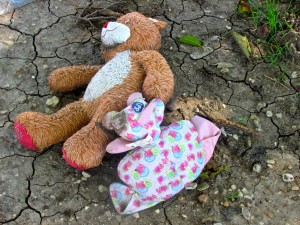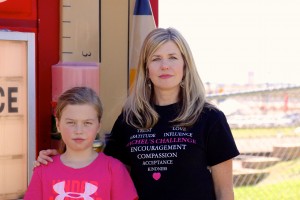Story by: Austin Eck
Photos by: Rebecca Malzahn
Bang.
The earth trembled as the shockwave traveled through the nearby neighborhoods. The French doors of a house were blown off their hinges and lodged themselves into an interior wall. Glass shattered and formed small missiles that took aim at anything and everything in their path. Insulation poured in from the ceiling forming a dirty, gray snow bank in the center of the room.
On April 17, 2013, the West Fertilizer Company’s plant caught on fire and exploded, killing 15, and a new chapter in the history of West was underway. The cause of the fire is unknown.
It was a Wednesday night, which meant religion class at the Church of the Assumption for Michele’s 9-year-old daughter, Lauren. Michele, principal of West Elementary School and Baylor graduate, dropped Lauren off at 6:15 p.m. like she had done so many times before. Behind West Middle School a fire was growing at the fertilizer plant. Michele, still unaware of what exactly was happening, deviated from her routine. Typically, her daughter’s religion class was a chance to walk the track at the middle school to get away from it all. On this day, she broke that habit and instead went to her parents’ house on the south side of town. As she was leaving to pick her daughter up from religion class, her parents invited her and her daughter to eat with them.
They were eating at the table when the walls shook, and there was a loud boom—a boom that will resonate in the ears of many citizens of West for years to come. The boom was so loud, it scared the children in the house. “I remember the kids just screamed at the top of their lungs,” said Michele. Immediately, the family tried to figure out what caused the noise. “We thought it was a burglar trying to break through the windows,” Lauren said.
Walking outside to make sense of the loud noise, Michele saw the superintendent of the school district who told her that the fertilizer plant had exploded. Panic struck as her thoughts shifted to her home, just a few blocks from the plant. Racing towards a mushroom cloud of smoke, she got within three blocks before the devastation became so apparent that she knew her house was gone. “It was unreal like a war zone,” she said. “A bomb had gone off.” The impact of the blast was not limited to buildings; it had left its mark on the people in the area as well. “When the blast took place, people must have been in their cars either seeing what was going on or driving by,” she said. “I just remember this one lady just had blood dripping down her face. I guess the windshield had exploded when she was in the car.”
Michele Scott’s house was not salvageable, but her focus did not shift to rebuilding it. Her attention was needed in the school system. As principal of West Elementary School, her main priority was getting her students back in school.
Her family did not stay in West that night, but found a hotel room in Waco instead. Plans to reopen schools were deliberated mere hours after the blast. Marty Crawford, superintendent of the West Independent School District, called a meeting for all of the administration and school board at 8 a.m. the following morning. “Our superintendent already had this goal; we needed to get kids back in school on Monday,” said Michele.
The following days were stressful. West Middle School about 1,000 feet from the plant was destroyed, and as a result its students were moved to the elementary school to continue their classes. School officials worked to convert storage rooms into classrooms for the incoming students from the middle school, and portable buildings had to be installed behind the school to house the excess students. “Was it kind of crazy? Yes, but everybody just stepped up, and did what we could do for the kids to keep their lives normal,” said Michele. “That was our big push. We got to get kids back in school. They’ve got to have some normalcy. All the adults were going crazy, so we had to be strong, pull together, get in there and start teaching.” That day counselors from across the state converged on West to help any student needing someone to listen. Others spent the day in the classroom with their teachers. “For the most part, teachers did their best to teach the kids that day,” Michele said. “They had curriculum; they were ready to go.”
One does not have to look far from the school to see the impact of the explosion in West. A drive down Reagan Street reveals a town picking up the pieces, rebuilding and bringing routine back to life. Traveling north along the street, visitors will pass through a residential part of town before encountering the high school football field and the plot where the middle school once stood. Seeing the football field and nothing else, there is no inclination of what happened months ago. The field looks like any other high school football field in Texas and now once again is a host to student athletes. On Friday nights, the lights beat down on the green field. Fans fill the bleachers the same way they once did. Below, young men compete in a game full of passion and excitement. This scene is a stark contrast to the flashing lights and sirens of the ambulances that overtook the field on the night of the blast.
Across the street, all that remains are the columns at the front of the school the children used to walk through on their way to class. The playground stands, and the bright yellows and blues of the equipment contrast against the white columns and gray rubble. The middle school track Michele use to pace, stands scarred from the blast. The red and black scoreboard that once illuminated middle school football scores has fallen to the ground.
Past the schools, faded black X’s speckle the front doors of residences, signaling danger. The chipped paint has worn thin from the rain and sunshine beating down. The grain of the wood shows through the faded X’s. Other houses are undergoing repairs and others, like Michele’s, have been demolished.
All along Reagan Street construction crews work to rebuild the lost homes. The yellow bulldozers push the brown dirt and workers quietly go about their tasks. The neighborhood is still until the hammer of a worker breaks the silence. Each impact echoes throughout the street, dies out slowly and the street falls silent again. “You have to help your neighbor,” said Jesus Buseamante, head of construction for A.A.A. Honest Concrete. “That’s what Jesus said, ‘Love your neighbor.’ Besides that you get a good feeling.”
Since the blast, Michele and Lauren have lived with her parents. Michele and other teachers who lost their homes have put personal matters on the backburner in order to help the school and the kids of West. “We didn’t ever stop,” she said. “After that explosion in April and May we were here just focusing on the kids.” But just because she is strong at school does not mean she is invincible. “I put on a pretty good game face here at school because I have to be strong,” Michele said. “I will be honest, there are times maybe once every month and half or two months I have to have some time away and try to process all of this.”
It would be easy to cut her losses and move out of town, and the thought has crossed her mind. “This is my home,” she said. “God is going to carry me through all of this. He got us this far; he’s not going to let us go now. I’m trying to just really stay strong in my faith. It’s going to work out he’s got a plan.” Six months after the fertilizer plant exploded, things are starting to return to normal at West Elementary School. Kids play on the playgrounds and smile after they complete a somersault and eagerly await their ride home at the end of the day. But there is more than meets the eye. “With everything we’ve been through, we’ve stuck together and we’re just doing what’s best for kids to keep their lives normal,” Michele said.
It is apparent, West is not the same as it was on April 16. The rebuilding process is far from over, and there is much to be done in the city. West’s community will not give up, and simply put: they will rebuild.



